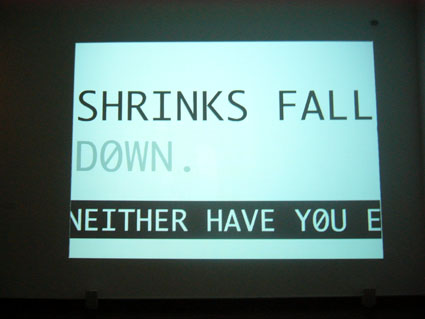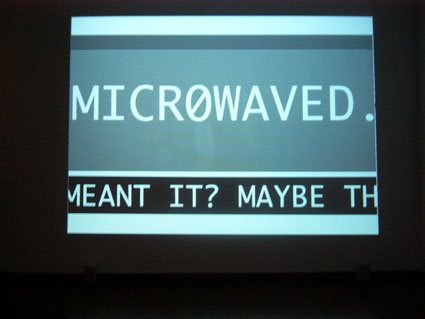 |
Young-Hae Chang Big Heavy Industries, All Fall Down |
In the now established Heavy Industries style ALL FALL D0WN is a Flash animation which plays with bold text in familiar Monaco type dashing at just readable speeds in rhythmic formation across a white background. Wary of the epileptic potential of the work I choose to initially engage with the scrolling band of text, white on black at the bottom at the bottom of the screen. It offers a Kerouac reverie of minutiae mixed with glimpses of sensuality: "How could you not slip your hand beneath those wisps and smooth them into place – a painter caring for his brush. You were desire those days."
Trying to absorb the narrative, my eye begins to catch the rhythmic play of large words pulsing across the upper, larger section of the screen. Gradually I give up on the horizontal text and try to latch onto the mostly 3 word statements that play across the screen, placed one word at a time then shrinking down and disappearing right of centre.
D0WNTOWN IS D0WN
UPT0WN IS D0WN
S0FTWARE IS FLAT
E-MAIL IS D0WN
PASSION FALLS D0WN
DESIRE FALLS D0WN
ANGELS BREAK D0WN
The text is so rich, yet so fast you are never completely sure what you are reading. Each phrase is linked to the one before, the mind grasping for connections and in the gap are rich and profound associations. Watching it a second time I see a whole new element I just couldn't keep up with before. In between each statement are brisk flashes—BIG words that fill the screen, white on black—each a response, an insult, a provocation, a commentary on the previous statement perfectly synchronised with percussive highpoints.
ALL FALL D0WN
YUP
CATS FALL D0WN
MEOW
DOGS FALL D0WN
WOOF
SKY FALLS D0WN
CHICKEN
D0WN ON ME
PLEASE
 |
Young-Hae Chang Big Heavy Industries, All Fall Down |
Opposite is Grant Stevens' Dazed and Praised. While the text of ALL FALL D0WN travels fast while remaining legible, Stevens' text slashes across the monitor at near impossible speed. Only when you don the headphones can you grasp it, the eye catching up with the ear. The text is a cutup of (mostly male) voices talking about some alternative culture with passion and nostalgia: "we were pushed and praised…we took the ruins of the 20th century and made art out of it…"
What exactly they are talking about remains a mystery so it is hard not to get sucked into a guessing game. I was very proud of myself for deciphering the subject as skateboard culture, but on reading the catalogue it seems that it might be a mixture of both 70s and 90s grunge rockumentaries. The absence of subject allows a kind of anthropological focus on the language which, with a flick of a marketing wrist could become an advertising slogan for the latest running shoe: "we were doing it cause we liked doing it…I'm doing it…"
Dazed and Praised is in interesting juxtaposition with ALL FALL D0WN, working with a similar graphic interface yet with very different preoccupations. Young Hae Chang's is about the act of reading and association, while Stevens' is about the spoken word with text as graphic accompaniment.
The final work in the gallery is Paul Lincoln's We the Citizens. Described as an "augmented reality work" it comprises a screen and second mobile LCD screen with mounted video camera. The instructions tell the viewer to point the camera up towards the air conditioning ducts in the gallery. If you hold it just right you can begin to see 3 dimensional red block words falling from the vents—"citizens, united, people, race, language, religion"—words that you later learn (from the catalogue) are taken from the Singapore Pledge of Allegiance. The interface functions well but the set up is awkward. The LCD screen attached to the camera has poor vision so you must either point the camera in one direction and then twist around to the larger monitor to interpret the words, or you need to work with someone.
Anecdotally we hear that there is a developing discourse around air conditioning dealing with westernisation and financial and class aspirations. These tidbits of information make the work far more meaningful. However as it is presented with no artist text (though, thankfully, there are instructions) the effect is underwhelming. This absence of information is a common flaw in the GRAVITY exhibition. While it is not necessary to accompany every artwork with an essay as to its conceptual preoccupations (works like ALL FALL D0WN require no explanation), We The Citizens exemplifies how some pointers about context could allow viewers to orient themselves to make more informed and focussed associations and have more satisfying experiences.
Since the initial Hypertext flurry of the late 90s, text has been a less visible tool for media based artists. However works such as ALL FALL D0WN, Dazed & Praised and to a lesser extent We The Citizens illustrate the power of words. The curatorial choice to present these works together was a good one. Maybe even Kerouac would click his appreciation.
Young Hae Chang's Big Heavy Industries, ALL FALL D0WN, Grant Stevens, Dazed and Praised, Paul Lincoln, We The Citizens, GRAVITY, Singapore Art Museum, curator Kim Machan, Oct 27 - Nov 28 ; MAAP in Singapore—Gravity, Oct 11-Nov 30
RealTime issue #64 Dec-Jan 2004
© Gail Priest; for permission to reproduce apply to [email protected]








 back
back